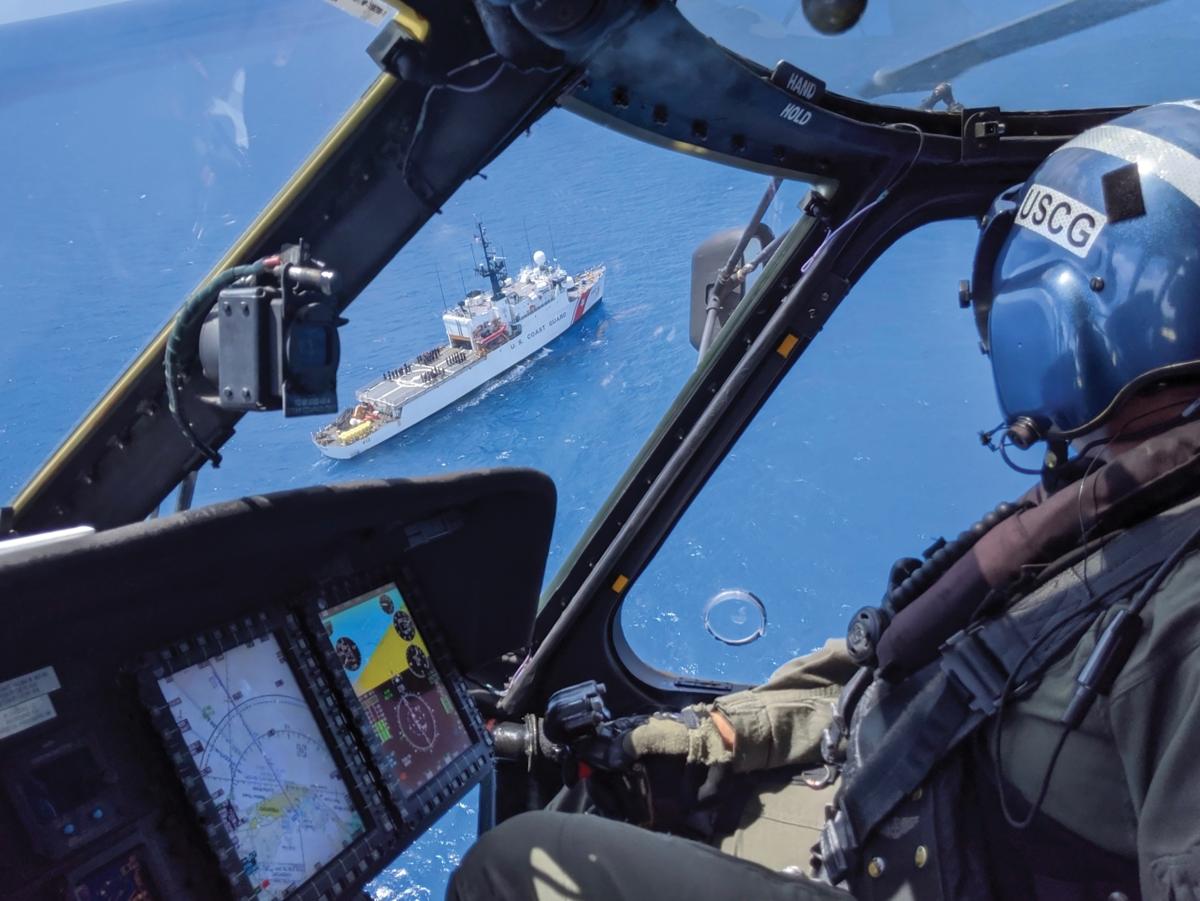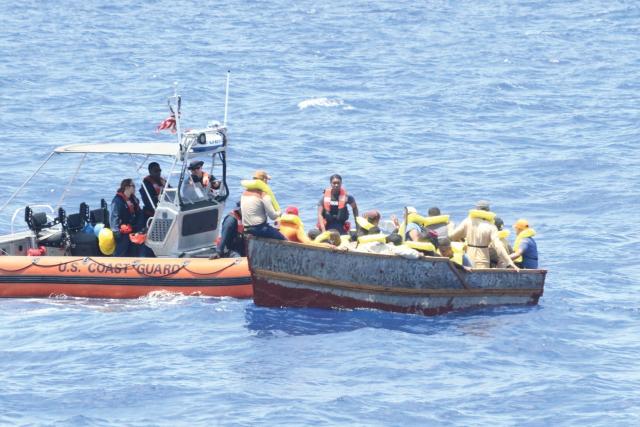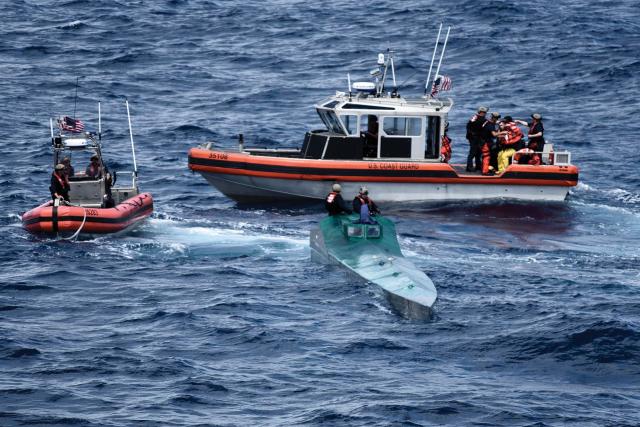During the 2019 government shutdown, the Coast Guard stayed the course, its members serving without pay in both day-to-day and hazardous operations. Despite hardships, leaders held firm, maintaining core values without complaint. Perhaps one of the clearest descriptions of the Coast Guard’s role came not from public affairs, but from a dependent who, when questioned during the shutdown, stated “We are the wall.”1 For decades, the Coast Guard has been a critical “wall” against illegal immigration, drug smuggling, and seaborne threats to national security. These missions changed in the aftermath of 9/11 as the service refocused to counterterrorism and potential attack on the homeland. Now, the wall may be moving again.
The recently released National Security Strategy (NSS) placed an emphasis on a changing world and the return of great power competition between nation-states and the United States’ role—a significant strategic shift. The NSS recognizes that the security and counterterrorism strategies that underpinned operations following the attacks of 9/11 were driven by a different world order; the United States will operate differently internationally going forward. To meet this challenge, the Coast Guard once again must adopt a new mission focus.
Old Missions, New Priorities
As a multimission service, the Coast Guard has always prioritized around its core missions, adapting and taking on new ones as geopolitical situations dictate. In the early 1970s, search and rescue held sway; then, the rise of maritime drug smuggling shifted to a broader law enforcement focus as the Coast Guard became “the Smokies of the Sea.” In the late 1980s, the Coast Guard focused on defense operations as part of the Navy’s maritime strategy, creating coastal defense organizations (the maritime defense zones) to counter potential Soviet offensive actions in a global conflict. The fall of the Soviet Union and the wreck of the Exxon Valdez shifted the Coast Guard’s focus to environmental and oil spill response. In the mid-1990s, the service sought balance to maintain core mission expertise. The 9/11 attacks caused another shift toward defense operations and a specialized focus on maritime counterterrorism.
Today, reaction to globalization has created populist trends that thrive on ancient rivalries, while the rise of China and reemergence of Russia as peer rivals have changed the world dramatically. The Coast Guard must consider its traditional mission sets and how these will change strategically.
Mission Review: Strategic Challenges
In reviewing its traditional missions, the Coast Guard must consider how the new world order will affect the service and its strategy in the following areas:
Illegal Immigration
The current administration has made illegal immigration a primary focus for the Department of Homeland Security, emphasizing activity on the southwest border. The core reason for increased migration—unlike previous migrations, which were primarily economic—is that asylum seekers are fleeing Central American countries whose conditions approach that of failed states. Migrant caravans are the current method of asylum seekers, but they are having mixed results at the border. It is very likely that migrants will turn to other methods to reach the United States. The sea can be an attractive option; it should not be.
Seaborne migration can be far more dangerous to migrants than travel on land. Stopping yolas and small craft from Haiti and Cuba have been a part of the Coast Guard’s Caribbean migrant interdiction mission for decades; these craft usually are massively overloaded and piloted by migrants with limited or no seagoing experience. The worst such cases are mass migrations, four of which the Coast Guard has faced in the past two decades, in which it intercepted more than 100,000 migrants at sea.2 If the border is made more secure—in rhetoric or practice—seaborne migration may be seen by migrants from troubled Central and South American countries as a viable option, either individually or through another mass migration.
The Coast Guard must update its migrant planning efforts to consider this possibility, including a review of training and capability to surge for a new and more diverse seaborne migration. Full consideration must be given not only to operational requirements, but also to the challenge of immediate media coverage. As the Deepwater Horizon oil spill taught the Coast Guard, information demands from media and Congress, and the challenge of responding to social media, can quickly overwhelm operational focus.3
Maritime Drug Interdiction
The Coast Guard has conducted a consistent counterdrug mission for years and is the most successful U.S. law enforcement organization in terms of seizure rates.4 The great challenge of the counterdrug mission—apart from the vast quantity of drugs being smuggled into the United States—is the diversity of smuggling methods used by narcotraffickers. Early smuggling on board pleasure craft and small merchant vessels gave way to go-fast speed boats and eventually semisubmersibles, with routes varying from the Caribbean to the Pacific and back again to avoid law enforcement.
The primary offload point for cocaine for the past two decades has been Mexico, where it is broken down and smuggled by “coyotes” and other means across the border. This has had the significant second-order effect of creating the Mexican cartels, whose violent battles over profitable smuggling routes have turned the border area into something akin to a war zone.5 Actions by the Mexican military and increased surveillance on the border may change this.
Given the strategic flexibility of the narcotraffickers, there may be a shift in smuggling methods. Recent interdictions of large cargoes of cocaine have been made near or in ports of entry in the United States, avoiding the border. Countering this may require shifting assets, a more forward presence of the Coast Guard fleet into new operating areas, an increased deployment of law enforcement detachments, and the negotiation of new bilateral agreements.6
Crisis Contingency Operations
U.S. Coast Guard
The past decade has seen a number of catastrophes that have required massive Coast Guard response. These crisis contingencies include oil spills, hurricanes, and other extreme weather events. It may begin as a localized event (such as the Deepwater Horizon oil spill) but can quickly overwhelm local response. What these crisis contingency operations share is that they occur on a large scale, happen quickly, have national impact, and demand a rapid and flexible response, usually involving multiple agencies.7
In such operations, sea power is a critical component. Hurricane Katrina indicates the level of response required. The Coast Guard ultimately deployed 42 cutters and 76 aircraft prior to and immediately after the storm. The service was credited with saving more than 31,000 lives during the evacuation. The widespread damage required a diverse response; offshore operations primarily focused on support to units ashore and on command and control—a key element illustrating the flexibility of sea power.
Crisis contingency operations are increasing in frequency. Category 4 hurricanes or higher no longer are a rarity. With extreme weather comes destruction—New Orleans, New Jersey, and Puerto Rico were devastated by killer storms. Increased offshore drilling brings an increased risk of another massive spill and would demand expert response.
As with a mass migration, the Coast Guard must plan and train for the surge operations demanded by such crises. However, these types of missions require a more diverse skill set, including enhanced afloat command and control, familiarity with operations not normally conducted, and an effective public relations campaign to halt the spread of misinformation.
Global Engagement
For many years, the Coast Guard has engaged in overseas defense missions as a force multiplier. These operations have touched multiple theaters, including the deployment of patrol boats to the Persian Gulf in support of combat operations and the use of high-endurance cutters with Navy battlegroups. These deployments have served not only to demonstrate the unique capabilities the Coast Guard brings to naval operations, but also to keep the service trained in wartime skills. However, in an age where there are increasing requirements in the U.S. hemisphere, should global operations continue?
As difficult as it may be, new mission requirements will require more assets in this hemisphere. While sending Coast Guard cutters to conduct freedom-of-the-seas operations in the Pacific may meet a Department of Defense requirement (given the number of Navy ships that can do this, it is a small requirement), there are other areas closer to home that require extended cutter presence. For example, turmoil in Central and South America will lead to second-order effects in migration and narcotrafficking, or even potential military operations if Venezuela continues its path toward a failed state. The turmoil in Central America is only increasing; if a show of force, diplomatic, or humanitarian assistance/disaster relief operation is required in this region, cutters are made for the task. The Coast Guard needs to plan to allocate forces now and begin training for this mission.
Counterterrorism Operations
U.S. Coast Guard (Paul King)
In the aftermath of 9/11, the Coast Guard responded to a largely unknown threat. The attacks illustrated the United States’ vulnerability to irregular operations; how and when the next attack would occur was unclear. What was clear, however, was that maritime facilities and the coastline were vulnerable. Accordingly, the Coast Guard spent a great deal of time and effort developing robust port security units, maritime safety and security teams, and a special maritime response team for counterterrorism operations. This effort was quite successful in meeting the challenges that arose from 9/11.
After almost 20 years of global conflict, the United States has learned that involvement in irregular warfare is long, costly, and a dubious use of national resources. This is reflected in the NSS and the call to return the focus on nation-state conflicts. This new direction will force the Coast Guard to ask hard questions—and make hard choices—about its counterterrorism capability. While no one is questioning the capabilities the Coast Guard has developed in this area, they are expensive. Can the Coast Guard continue to fully fund its counterterrorism efforts? Given that the world still faces irregular threats, would it be foolhardy to give up these capabilities? What are the advantages of keeping them—and paying for them?
Given the impact these decisions will have on personnel, mission, and budget, the degrees to which the service should focus on counterterrorism is one of the most difficult questions facing it.
Shifting the Wall
Throughout its existence, the Coast Guard has demonstrated its importance to U.S. national security strategy while constantly adapting its missions. The NSS’s focus on nation-state conflict, the speed of decisions made in the political realm, and operations in this hemisphere (including on the southwestern border), demand the service adjust its focus again. The Coast Guard is a wall against many things. Now it must choose, prioritize, and plan how it will face the challenges of the new world order.
1. Nick Davis, “We Are the Wall—A Commentary on the Coast Guard Shutdown,” Alt World Studios, 15 January 2019.
2. LT Katie Braynard, USCG, “225 Years of Service to Nation: Migrant Interdiction,” Coast Guard Compass, 16 June 2015.
3. Information demands—from both the media and Congress—for the Deepwater Horizon event were so great that a staff of more than 100 personnel was established to handle the requests, a very difficult if not impossible task given constant media and especially social media attention. This, in turn, generated new media/congressional inquiries.
4. 3WTKR, “Local Coast Guard Cutters Offload 27,000 Pounds of Cocaine in Florida,” 3WTKR.com, 22 March 2019.
5. Eli Mexler, “Cartel-Ravaged Mexico Sets a New Record for Murders,” Time, 22 January 2019.
6. The Coast Guard over time has negotiated 45 bilateral agreements with Caribbean nations for law enforcement operations that have improved counterdrug operations. U.S. Department of State, “2014 International Narcotics Strategy Report, volume I: Drug and Chemical Control” (2014).
7. R. B. Watts, “The New Normalcy: Sea Power and Contingency Operations in the Twenty-First Century,” Naval War College Review 65, no. 3 (Summer 2012).





